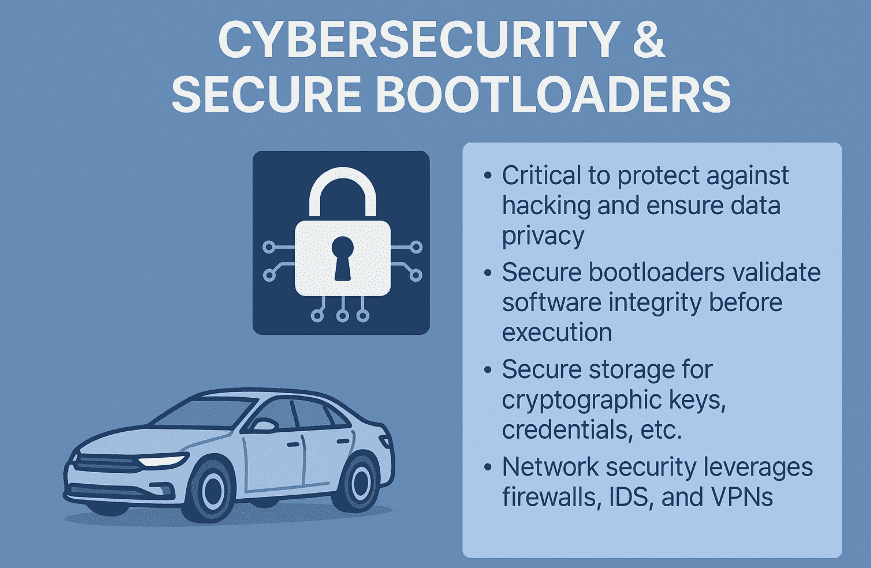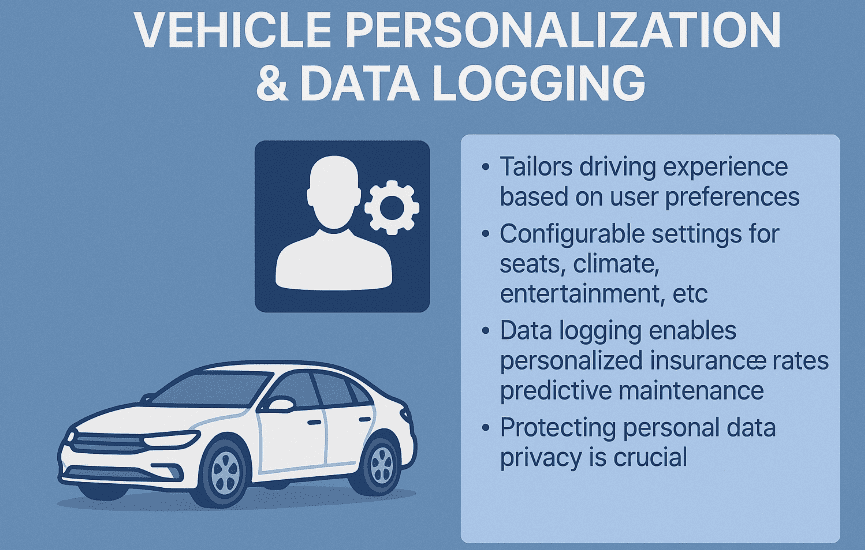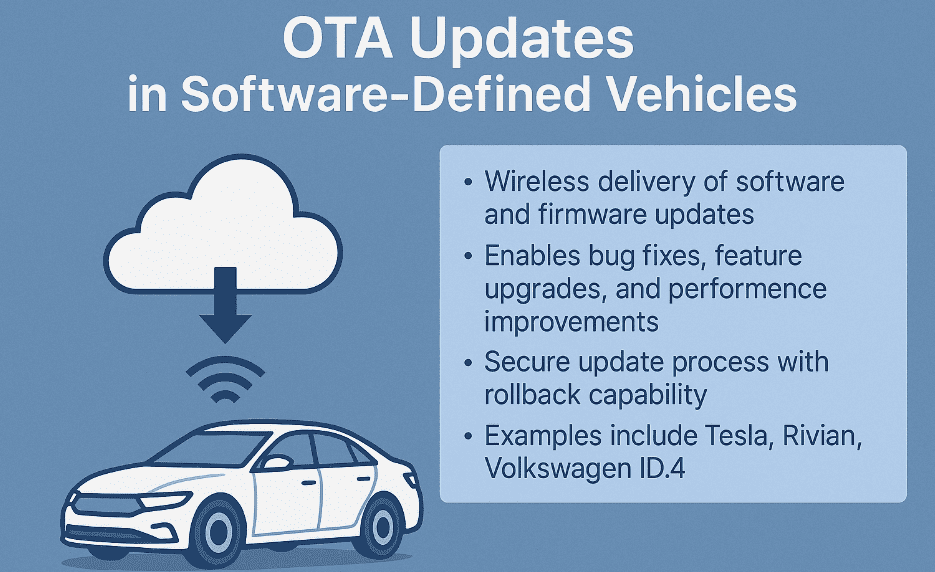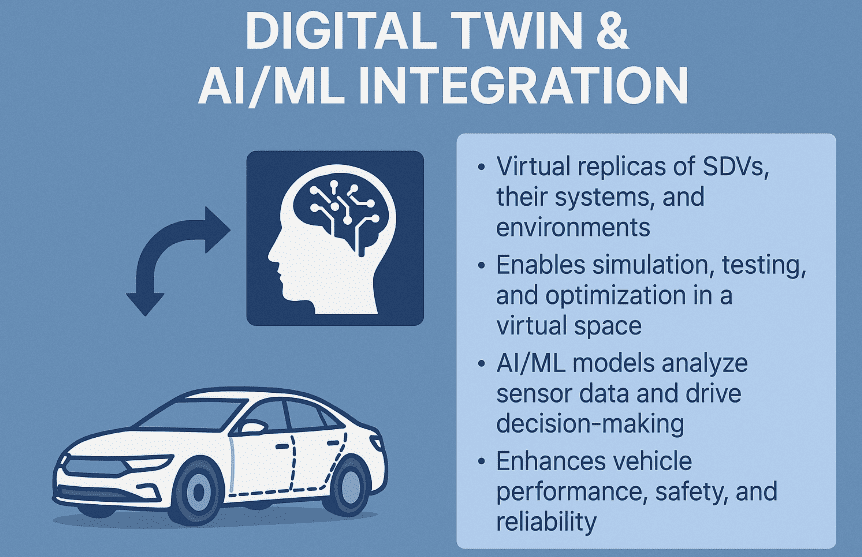Software-Defined Vehicles Enabling Technologies: Part 04
Hello guys, welcome back to our blog. In this article, I will discuss software-defined vehicles enabling technologies such as over-the-air updates, digital twin & AI/ML integration, cybersecurity, and secure bootloaders.
Ask questions if you have any electrical, electronics, or computer science doubts. You can also catch me on Instagram – CS Electrical & Electronics
- Core Software Layers In Software Defined Vehicles: Part 03
- Software-defined Vehicle Architecture: Part 02
- Introduction To Software-Defined Vehicle (SDV): Part 01
Software-Defined Vehicles Enabling Technologies
The automotive industry is undergoing a paradigm shift — one where vehicles are no longer defined solely by their mechanical prowess, but increasingly by software sophistication and computational intelligence. At the heart of this transformation is the Software-Defined Vehicle (SDV) — a platform that relies heavily on continuous software development, flexible architectures, and data-centric operations.
In an SDV, software takes precedence over hardware, enabling rapid updates, customization, enhanced functionality, and improved user experiences throughout the lifecycle of the vehicle. However, what truly makes this possible are the underlying enabling technologies that support this dynamic framework.
Technologies such as Over-the-Air (OTA) updates, Digital Twin systems, AI/ML, cybersecurity measures, and vehicle data intelligence are central pillars that support the realization of SDVs. These are not just optional add-ons — they are critical enablers that ensure scalability, flexibility, and reliability.
This section dives deep into the core enabling technologies that power the SDV ecosystem, highlighting their roles, challenges, and significance in delivering the future of mobility.
Over-The-Air (OTA) Updates
✅ Redefining Vehicle Lifecycle Management
OTA updates have redefined how software is deployed and managed in modern vehicles. No longer do vehicle owners need to visit service centers for routine software enhancements. OTA allows manufacturers to remotely update software components, from infotainment interfaces to performance settings and even mission-critical firmware.
🔄 Types of OTA Updates
There are two main categories of OTA updates:
- Firmware Over-the-Air (FOTA): This involves updating the low-level software, such as ECU firmware, typically related to engine control, braking, or battery management.
- Software Over-the-Air (SOTA): These updates focus on high-level features like infotainment, navigation, driver assistance settings, and app ecosystems.
Each update type requires a reliable backend infrastructure capable of secure deployment and rollback mechanisms in case of failure. Efficient delta update mechanisms are also used to reduce bandwidth by only sending changed portions of code.
🔐 Security Considerations
Given the critical nature of vehicle software, OTA updates must be highly secure and robust. This involves cryptographic signing, mutual authentication between the server and the vehicle, and secure boot processes. Malicious update injections or man-in-the-middle attacks could compromise driver safety.
💡 Benefits and Future Outlook
- Reduced Recall Costs: Manufacturers can fix bugs and improve functionality without physical recalls.
- Continuous Improvement: Vehicles can be enhanced post-sale, much like smartphones.
- Subscription-Based Features: Manufacturers can monetize features through trial and subscription models (e.g., heated seats, advanced cruise control).
With OTA updates, vehicles move from being static machines to living products, constantly evolving through software.
🧠 Digital Twin and AI/ML Integration
🌐 What is a Digital Twin in Automotive?
A Digital Twin is a real-time, virtual replica of a physical system. In automotive, it represents the digital equivalent of a car or its subcomponents, continuously updated through sensor data, edge computing, and cloud infrastructure.
Digital Twins are crucial in SDVs for simulation, predictive maintenance, design validation, and real-time performance monitoring. They allow engineers to test software changes in a simulated environment before deployment, reducing risk and speeding up development cycles.
🤖 AI/ML in Software-Defined Vehicles
Artificial Intelligence and Machine Learning algorithms are integrated throughout the SDV stack to enable:
- Advanced Driver Assistance Systems (ADAS): Real-time decision-making in scenarios like lane changes, obstacle avoidance, and pedestrian detection.
- Voice Assistants and Natural Language Processing: Enhancing HMI Interfaces.
- Driver Behavior Prediction: Detecting fatigue, distraction, and adapting driving modes accordingly.
- Traffic and Route Optimization: Using historical data and real-time feeds to dynamically adjust routes.
ML algorithms are trained using both vehicle data logs and simulation data from digital twins. Over time, these models become more accurate, reliable, and tailored to both vehicle and driver preferences.
🔁 Closed-Loop Learning and Feedback
AI/ML systems in SDVs are empowered by continuous learning loops:
- Data collection from onboard sensors.
- Transmission to cloud platforms.
- Model retraining based on new data.
- Deployment of updated models back to the vehicle.
This closed-loop ensures that the vehicle adapts and improves over time — another major differentiator from traditional vehicles.
🛡️ Cybersecurity and Secure Bootloaders

🧩 Cyber Threats in SDVs
With increasing connectivity and reliance on software, vehicles become cyber-physical systems vulnerable to external attacks. These threats could target:
- ECUs via CAN Bus injection.
- Infotainment systems via Bluetooth/Wi-Fi.
- Telematics through cellular communication.
To safeguard the SDV, cybersecurity must be designed-in from the ground up, not bolted on as an afterthought.
🛡️ Role of Secure Bootloaders
A secure bootloader is a security mechanism that ensures only verified and authenticated code is executed during the boot process. It acts as a gatekeeper, checking for:
- Cryptographic signatures.
- Hash verifications.
- Rollback protection (prevents installing outdated, vulnerable firmware).
This ensures that even if an attacker gains access to the vehicle, unauthorized code execution is blocked.
🔐 Multi-Layered Defense Strategy
Modern SDVs adopt a Defense-in-Depth strategy, including:
- Intrusion Detection Systems (IDS): Monitors abnormal network behavior.
- Hardware Security Modules (HSM): Perform encryption and decryption securely.
- Key Management Systems: Ensures secure key storage and rotation.
- End-to-End Data Encryption: For all V2X and OTA communications.
Furthermore, the upcoming UNECE WP.29 and ISO/SAE 21434 standards mandate stringent cybersecurity management systems for OEMs, making security compliance a legal necessity.
🧬 Vehicle Personalization and Data Logging

🚗 Personalization as a Differentiator
Modern consumers expect their vehicles to recognize them, adapt to their preferences, and respond like intelligent digital companions. SDVs enable deep personalization through user profiles stored either locally or in the cloud.
Personalized elements include:
- Seat and mirror positions.
- Climate control preferences.
- Infotainment playlists.
- Navigation favorites.
- ADAS sensitivity settings.
Cloud-linked user profiles mean that users can carry their preferences across vehicles — a game-changer in shared mobility and fleet environments.
📈 Data Logging and Analytics
Data logging in SDVs captures a wide array of information, including:
- Sensor data (LIDAR, RADAR, cameras).
- ECU diagnostics.
- Battery usage patterns.
- User interaction metrics.
This data is foundational for:
- Predictive Maintenance.
- Behavioral Analytics.
- Warranty Optimization.
- AI Training and Validation.
Data is often pre-processed at the edge and synced to the cloud during low-bandwidth consumption windows.
⚖️ Privacy and Data Regulation
With great data comes great responsibility. Compliance with regulations like GDPR, CCPA, and India’s DPDP Bill is essential. Users must have:
- Transparency over data usage.
- Control over data sharing.
- Secure opt-in/opt-out mechanisms.
OEMs must strike a balance between leveraging data for innovation and preserving user trust through ethical data handling.
🧩 Conclusion: Empowering the Future of Mobility
The Software-Defined Vehicle is not merely an evolution in vehicle design — it is a transformation in the vehicle’s identity, turning it into a smart, dynamic, connected platform on wheels. The enabling technologies discussed above are the core building blocks that support this transformation.
- OTA updates ensure vehicles remain up to date and adaptable.
- Digital twins and AI/ML inject intelligence and foresight into the system.
- Cybersecurity frameworks ensure resilience in an increasingly connected world.
- Vehicle personalization and data logging redefine user experience and operational intelligence.
Together, these technologies create an SDV ecosystem that is modular, secure, intelligent, and future-ready. As we move toward autonomous, electric, and connected mobility, mastering these enabling technologies will be essential for every stakeholder—from OEMs and Tier 1 suppliers to cloud providers and policy-makers.
In this new era, vehicles won’t just drive — they will evolve, learn, and communicate, ushering in a future where software defines the soul of the machine.
This was about “Software-Defined Vehicles Enabling Technologies“. Thank you for reading.
Also, read:
- 100 (AI) Artificial Intelligence Applications In The Automotive Industry
- 2024 Is About To End, Let’s Recall Electric Vehicles Launched In 2024
- 50 Advanced Level Interview Questions On CAPL Scripting
- 7 Ways EV Batteries Stay Safe From Thermal Runaway
- 8 Reasons Why EVs Can’t Fully Replace ICE Vehicles in India
- A Complete Guide To FlexRay Automotive Protocol
- Adaptive AUTOSAR Vs Classic AUTOSAR: Which One For Future Vehicles?
- Advanced Driver Assistance Systems (ADAS): How To Become An Expert In This Growing Field



